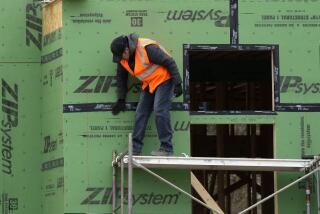Fed official: Job gains dominated by lower-paying work

- Share via
WASHINGTON — Federal Reserve Chairman Ben S. Bernanke made clear this week that he wanted to see “sustained” improvement in job growth and the unemployment situation before rolling back or halting monetary stimulus to the economy. On Friday, one of his colleagues on the Fed board pointed to another concern about the labor market: the quality of many of the newly created jobs.
Sarah Raskin, a Fed governor, noted that a little more than half of the job gains since the recovery have been in lower-wage occupations such as retail sales and restaurant work — even though they made up about one-fifth of the job loss caused by the Great Recession.
Moreover, Raskin said employers are increasingly relying on part-time and temporary staff, the so-called contingent workforce. Although 10% of job losses during the recession were temporary work, these jobs have accounted for more than 25% of the net employment gains since the recovery, she said, citing research from the American Staffing Assn.
“The flexibility may be beneficial for workers who want or need time to address their family needs,” she said in prepared remarks at the National Community Reinvestment Coalition’s annual conference in Washington. “However, workers in these jobs often receive less pay and fewer benefits than traditional full-time or ‘permanent’ workers ... and often have no real pathway to upward mobility in the workplace.”
Other economists have warned about the uneven job growth since the job-market recovery began about three years ago. About half the jobs that disappeared in the last recession were in the manufacturing and construction industries, which on average pay better and provide more hours than work in retail, leisure and some other service sectors.
In fact, Raskin noted that about two-thirds of the recession’s job losses were in moderate-paying occupations in manufacturing, skilled construction and office administration. But less than one-fourth of subsequent job gains have come in these occupations.
The Fed has said it would probably keep pumping tens of billions of dollars into the financial system until the outlook for the labor market showed substantial progress. Bernanke noted Wednesday that the private sector has added more than 200,000 jobs a month on average in the last five months and that the jobless rate has dropped 0.4 percentage point since September. Plus, jobless claims have fallen to the lowest levels since the financial crisis. Still, that wasn’t enough for the Fed to slow its monthly purchases of $85 billion of Treasury and mortgage securities.
Raskin’s remarks Friday indicate that the quality of the jobs and their share of overall growth matter too. Yet she also acknowledged the limits of the Fed’s ability on this front.
“While the Federal Reserve’s monetary policy tools can be effective in promoting stronger economic recovery and job gains,” she said, “they have little effect on the types of jobs that are created, particularly over the longer term.”
ALSO:
Hiring picks up as housing market recovers
California unemployment rate holds at 9.8%, highest in U.S.
More to Read
Inside the business of entertainment
The Wide Shot brings you news, analysis and insights on everything from streaming wars to production — and what it all means for the future.
You may occasionally receive promotional content from the Los Angeles Times.











